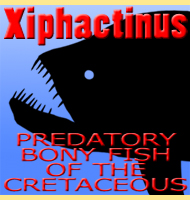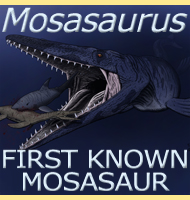


Rhinconichthys
Name:
Rhinconichthys.
Phonetic: Rin-kon-ik-fiss.
Named By: Matt Friedman, Kenshu Shimada, Larry
D. Martin, Michael J. Everhart, Jeff Liston, Anthony Maltese
& Michael Triebold - 2010.
Classification: Chordata, Actinopterygii,
Pachycormiformes, Pachycormidae.
Species: R. taylori , R.
purgatoirensis, R. uyenoi.
Diet: Filter feeder.
Size: R. purgatoirensis about
2 - 2.7
meters long. R. uyenoi. about 3.4-4.5
meters long.
Known locations: England. Japan - Mikasa
Formation. USA, Colorado - Carlile Shale.
Time period: Turonian of the Cretaceous.
Fossil representation: Partial remains of several
individuals.
Rhinconichthys
was first named in 2010, from fossils that had been discovered in
England. Then in 2016 a description of two new species, R.
uyenoi from Japan and R. purgatoirensis
from the
USA were
described, revealing to us that this fish genus potentially had a
global distribution. Rhinconichthys is noted for
the large
hyomandibulae bones which would have allowed this to have had an
incredibly wide gape, in turn allowing Rhinconichthys
to filter
large amounts of plankton from the sea water.
Rhinconichthys
is related to the genera Bonnerichthys
and Leedsichthys.
Further reading
- 100-million-year dynasty of giant planktivorous bony fishes in the
Mesozoic seas. - Science 327 (5968): 990–993. - Matt
Friedman, Kenshu Shimada, Larry D. Martin, Michael J.
Everhart, Jeff Liston, Anthony Maltese & Michael
Triebold - 2010.
- Highly specialized suspension-feeding bony fish Rhinconichthys
(Actinopterygii: Pachycormiformes) from the mid-Cretaceous of the
United States, England, and Japan. - Cretaceous Research 61:
71–85. - Bruce Schumacher, Kenshu Shimada, Jeff Liston,
Anthony Maltese - 2016.
----------------------------------------------------------------------------
Random favourites
 |
 |
 |
 |




